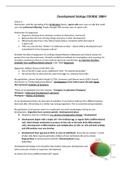Samenvatting
Developmental biology summary COURSE 10
- Instelling
- Hogeschool Arnhem En Nijmegen (HAN)
Dit is een samenvatting van de course 10 theorielessen over developmental biology. Zelf heb ik na het leren van deze samenvatting een 8.1 gehaald voor thematoets (zonder herkansing)! This is a summary of the course 10 theory lessons on developmental biology. After learning this summary, I myself o...
[Meer zien]




